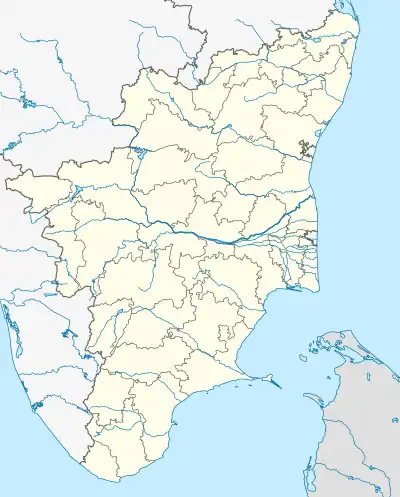Samanatham
Samanatham is the name of a panchayat village in the Madurai district of Tamil Nadu, India.[1] It comes under the Thiruparankundram block.[2]"Sama Natham" a corrupt version of 'Samanar Rattham' or 'blood of Jains' is situated about six kilometers away from Madurai and a winding path among Acacia bushes and thorns leads one to a place worshipped as Mayandi temple. The place is isolated and is located in an eerie environment. But for the 10 foot trident and stone pillars with a hanging bell, there is nothing to suggest that it is a temple.
Samanatham (Meenakshi nagar 625009) | |
|---|---|
village | |
 Samanatham (Meenakshi nagar 625009) Location in Tamil Nadu, India  Samanatham (Meenakshi nagar 625009) Samanatham (Meenakshi nagar 625009) (India) | |
| Coordinates: 9.866674°N 78.14719°E | |
| Country | |
| State | Tamil Nadu |
| District | Madurai |
| Block | Thiruparankundram |
| Population (2001) | |
| • Total | 2,218 |
| Languages | |
| • Official | Tamil |
| Time zone | UTC+5:30 (IST) |
Conversion of Jains at the point of sword
The villagers and the local boys are acquainted with the history of the place. They describe the place as "Samanar Rattham" or 'blood of Jains' where Jains, who refused conversion to Shaivism, were killed en masse after their defeat in the challenge of the Fire and Water debates with the Shaivite Saint, Gnanasambandhar conducted before the Pandiya king, Arikesari Maravarman (7th century CE). The place where the pogrom by impalement took place is called as 'Samanar Medu' in Samanatham.
These events recorded in the narrative of Gnanasambandhar are displayed in the fifth of the twelve festivals conducted in Madurai Meenakshi Amman temple. On these occasions, which are known as impaling festival, an image symbolising a Jain impaled on a stake is carried in procession. According to a tradition, the villages of Mela Kilavu and Kil Kilavu near Sholavandan are so named because the stakes (Kilavu) for impalement extended so far from the City of Madurai. On this, Edgar Thurston had also suggested the reading of A.Guerinot's 'Essai de Bibliographie Jaina', at Annales du Musee Guimet, in Paris.
See also
- Impalement of the Jains in Madurai, a Shaivite legend about the killing of around 8000 Jains by the Pandyan king Koon Pandiyan at Samanatham
References
- "Integrated Management Information System (IMIS) report". Ministry of Drinking Water and Sanitation, Government of India. Retrieved 25 February 2013.
- "NREGA Report". Ministry of Rural Development, Government of India. Retrieved 25 February 2013.